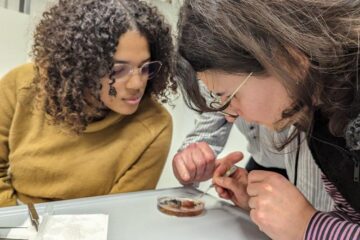Tracking the memory trace

Memory formation follows a dynamic pattern, allowing for retrieval from different areas of the brain, depending on when an organism needs to remember, said a researcher at Baylor College of Medicine.
That is what Dr. Ron L. Davis, professor of molecular and cellular biology at BCM, theorizes, based on his most recent report on the topic that finds a memory trace in Drosophila or fruit flies is formed in a pair of neurons called the dorsal pair medial neurons, but only 30 minutes after the fact and only through the mediation of a gene called, ironically, amnesiac. (A memory trace is a chemical change in tissue that represents the formation of a memory.) The study appears in the current issue of the journal Cell.
Davis and his colleagues were one of the first to actually record a memory trace being formed. That one was first stored in the insect’s antennal lobe (where odors are processed). The flies are trained to associate an odor with an electric shock. The change in these neurons was immediate, but lasted only five to seven minutes.
In the more recent report involving the DPM neurons, the change can be seen 30 minutes after the formation of the memory, but it lasts about two hours.
“The other intriguing thing we don’t understand is that this occurs only in one branch of the DPM neuron,” said Davis. “Our impression now is that maybe what guides the behavior after training in the first few minutes is the antennal lobe. That is the important part that guides behavior for the small window of time after training. The DPM neurons have that role from 30 minutes to two hours.”
The finding belies the commonly held precept that a memory is formed in the same way that data are stored in a computer – always in the same place.
“It’s not as if we are forming memories that are then being written to a “hard disk” area of the brain, and it’s there and recalled from the same location at any time after learning,” said Davis. “We now think that different areas of the brain have dominion over small intervals of time after training. One area might have dominion and then another.” Others who participated in the research include Drs. Dinghui Yu and Anjana Srivatsan, both of BCM, and Scott Waddell and graduate student Alex Keene, of the University of Massachusetts Medical Center.
Media Contact
More Information:
http://www.bcm.tmc.eduAll latest news from the category: Life Sciences and Chemistry
Articles and reports from the Life Sciences and chemistry area deal with applied and basic research into modern biology, chemistry and human medicine.
Valuable information can be found on a range of life sciences fields including bacteriology, biochemistry, bionics, bioinformatics, biophysics, biotechnology, genetics, geobotany, human biology, marine biology, microbiology, molecular biology, cellular biology, zoology, bioinorganic chemistry, microchemistry and environmental chemistry.
Newest articles

A new look at the consequences of light pollution
GAME 2024 begins its experiments in eight countries. Can artificial light at night harm marine algae and impair their important functions for coastal ecosystems? This year’s project of the training…

Silicon Carbide Innovation Alliance to drive industrial-scale semiconductor work
Known for its ability to withstand extreme environments and high voltages, silicon carbide (SiC) is a semiconducting material made up of silicon and carbon atoms arranged into crystals that is…

New SPECT/CT technique shows impressive biomarker identification
…offers increased access for prostate cancer patients. A novel SPECT/CT acquisition method can accurately detect radiopharmaceutical biodistribution in a convenient manner for prostate cancer patients, opening the door for more…





















